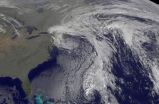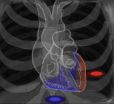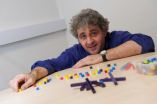(Press-News.org) The GOES-13 satellite is watching a flurry of activity in the Atlantic Ocean today as a cold front approaches the remnants of Hurricane Tomas and threatens to swallow it in the next couple of days.
Tomas is now a remnant low pressure area is located in the Atlantic near 26 North and 68 West hundreds of miles south-southwest of Bermuda and has a minimum central pressure of 994 millibars today, Nov. 8. A cold front off the U.S. East Coast however, is stalking Tomas' remnants and moving east threatening to swallow the former hurricane.
The Geostationary Operational Environmental Satellite known as GOES-13 captures visible images of the eastern half of the U.S. and Atlantic Ocean basin during daylight hours and infrared images during night-time hours. Two GOES satellites cover the U.S., one the western half of the country, and the other, GOES-13, the eastern half of the country. GOES satellites are operated by NOAA, and the NASA GOES Project at NASA's Goddard Space Flight Center in Greenbelt, Md. creates images and animations using the satellite data.
GOES-13 captured an image of the cold front stalking Tomas' remnants in the Atlantic Ocean on Nov. 8 at 1345 UTC (8:45 a.m. EST). The cold front appears on the satellite imagery as a line of clouds east of the U.S. East coast that looks like a question mark. Tomas' remnants appear as a tight swirl of clouds at the bottom of that line of clouds near Bermuda.
By 6 p.m. Eastern Standard Time on Nov. 7, Tomas had lost its tropical characteristics and its warm core. Tomas had more resembled a frontal system with cold air stratocumulus clouds wrapping into its center. At that time, Tomas was about 500 miles south-southwest of Bermuda near 26.1 North and 69.1 West. It still had maximum sustained winds of 60 mph, and more resembled a nor'easter meteorologically speaking. It was moving north-northeast near 3 mph and had a minimum central pressure of 997 millibars at that time. When Tomas was at that location, the National Hurricane Center issued their last advisory on the system.
Tomas' remnant low pressure area has become a "post-tropical cyclone" and is forecast to continue moving northeast and east-northeastward until it is absorbed by a frontal system.
That cold front is currently located to the west of Tomas near 32 degrees North latitude and 66 degrees West longitude. It is expected to continue moving east and absorb Tomas' remnants in the next day or two.
INFORMATION:
NASA's Hurricane page: www.nasa.gov/hurricane
GOES-13 satellite sees cold front stalking remnant low of Tomas
2010-11-09
ELSE PRESS RELEASES FROM THIS DATE:
NASA sees Tropical Depression Jal's remnants entering and leaving India
2010-11-09
Jal was a tropical storm when it made landfall this weekend on the east coast of India and tracked across the country while weakening into a remnant low pressure area. NASA's Terra satellite captured an image of Jal's center as it was entering eastern India and NASA's Aqua satellite captured an infrared image as it was departing the country.
This weekend, Tropical Cyclone Jal made landfall in east central India and crossed the northern coast of Tamil Nadu and southern coast of Andhra Pradesh, north of Chennai. It dropped heavy rainfall and created some flooding. Gusty ...
Soy may stop prostate cancer spread
2010-11-09
CHICAGO --- Northwestern Medicine researchers at the Robert H. Lurie Comprehensive Cancer Center of Northwestern University have found that a new, nontoxic drug made from a chemical in soy could prevent the movement of cancer cells from the prostate to the rest of the body.
These findings will be presented at the Ninth Annual American Association for Cancer Research Frontiers in Cancer Prevention Research Conference.
Genistein, a natural chemical found in soy, is being used in the lab of Raymond Bergan, M.D., the director of experimental therapeutics at the Lurie Cancer ...
Fat sand rats are SAD like us
2010-11-09
Saying goodbye to summer can be difficult for everybody. In some people the onset of winter triggers Seasonal Affective Disorder, or SAD, a mood disorder in which sufferers experience symptoms of depression. Happily, a special kind of gerbil exhibits remarkably similar reactions to SAD treatments as humans, opening a promising new channel for study and treatment of the common complaint.
With her work on the Israeli desert inhabitant gerbil called the Fat Sand Rat (Psammomys obesus), Prof. Noga Kronfeld-Schor of Tel Aviv University's Department of Zoology and her fellow ...
UCLA uses new hybrid, precision heart procedures to help stop deadly arrhythmias
2010-11-09
New techniques now being used at UCLA allow doctors to more precisely target certain areas of the heart to stop ventricular arrhythmias — serious abnormal rhythms in the heart's lower chambers — in high-risk patients.
Generally, arrhythmias can be controlled by medications, and sometimes defibrillators. But a potentially life-threatening, recurrent arrhythmia known as a ventricular tachycardia, which originates in one of the heart's two ventricles, can produce a fast heart beat that requires other interventions, such as catheter ablation, in which the precise focus ...
Children find their own way to solve arithmetic problems
2010-11-09
Children with learning difficulties can benefit from being encouraged to find their own way to solve arithmetic problems, according to new research from the University of Strathclyde in Glasgow, Scotland.
A study by Dr Lio Moscardini, in Strathclyde's Faculty of Humanities & Social Sciences, found that children deal better with arithmetical problems if they can use their own intuitive strategies such as using number blocks, drawings or breaking an equation up into smaller, simpler parts- rather than being instructed in arithmetical facts and procedures.
All the teachers ...
Brain bleeding is common with aging, UCI study finds
2010-11-09
Irvine, Calif., Nov. 8, 2010 — A small amount of bleeding in the brain seems to be common among older individuals, according to a UC Irvine study.
Neurologist Dr. Mark Fisher and neuropathologist Dr. Ronald Kim found that cerebral microbleeds are highly prevalent in the aging brain – and not primarily products of stroke-related injury, hypertension or neurodegenerative diseases such as Alzheimer's, as had been thought.
"Prior work relied on brain imaging to show cerebral microbleeds," Fisher said. "But in this study, deep regions of the brain were closely examined under ...
Scientists discover how the songbird's brain controls timing during singing
2010-11-09
AUDIO:
New research that reveals the activity of nerve cells in a songbird's brain as the bird sings a specific song is helping scientists to understand how birds string together sets...
Click here for more information.
A team of scientists has observed the activity of nerve cells in a songbird's brain as it is singing a particular song. Dezhe Jin, an assistant professor in the Department of Physics at Penn State University and one of the study's authors, explained that ...
Stevens and TNO conduct joint experiments in Dutch Harbor for maritime security
2010-11-09
Hoboken, NJ – Stevens Institute of Technology and the Netherlands Organization for Applied Scientific Research (TNO) have recently conducted joint experiments in the Dutch Navy Harbor of Den Helder, where passive acoustic systems from both parties were combined. Initial experimental results are presented at the Waterside Security (WSS) 2010 conference. This important experimental campaign was financed by the Netherlands Ministry of Defence.
The collaboration between Stevens and TNO was initiated in early 2010 after recognizing a strategic opportunity to form a long-term ...
TB-drugome provides new targets for anti-tuberculosis drug discovery
2010-11-09
Researchers at the University of California, San Diego School of Medicine and the University of Leeds have linked hundreds of federally approved drugs to more than 1,000 proteins in Mycobacterium tuberculosis, the causative agent of tuberculosis (TB), opening new avenues to repurpose these drugs to treat TB.
The study was published Nov. 4 in PLoS Computational Biology.
"Tuberculosis is currently one of the most widely spread infectious diseases, with an estimated one-third of the world's population infected and between one and two million people dying each year from ...
DHA improves memory and cognitive function in older adults
2010-11-09
WASHINGTON, D.C., November 8, 2010 — A study published in the November edition of Alzheimer's & Dementia: The Journal of the Alzheimer's Association suggests that taking docosahexaenoic acid (DHA) may improve memory and learning in older adults with mild cognitive impairments. This is promising news for many aging Americans who are searching for options to maintain memory and support overall cognitive health.
The "Memory Improvement with Docosahexaenoic Acid Study" (MIDAS) was a randomized, double-blind, placebo-controlled study to evaluate the effects of DHA—the principle ...





